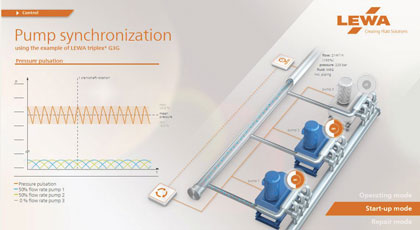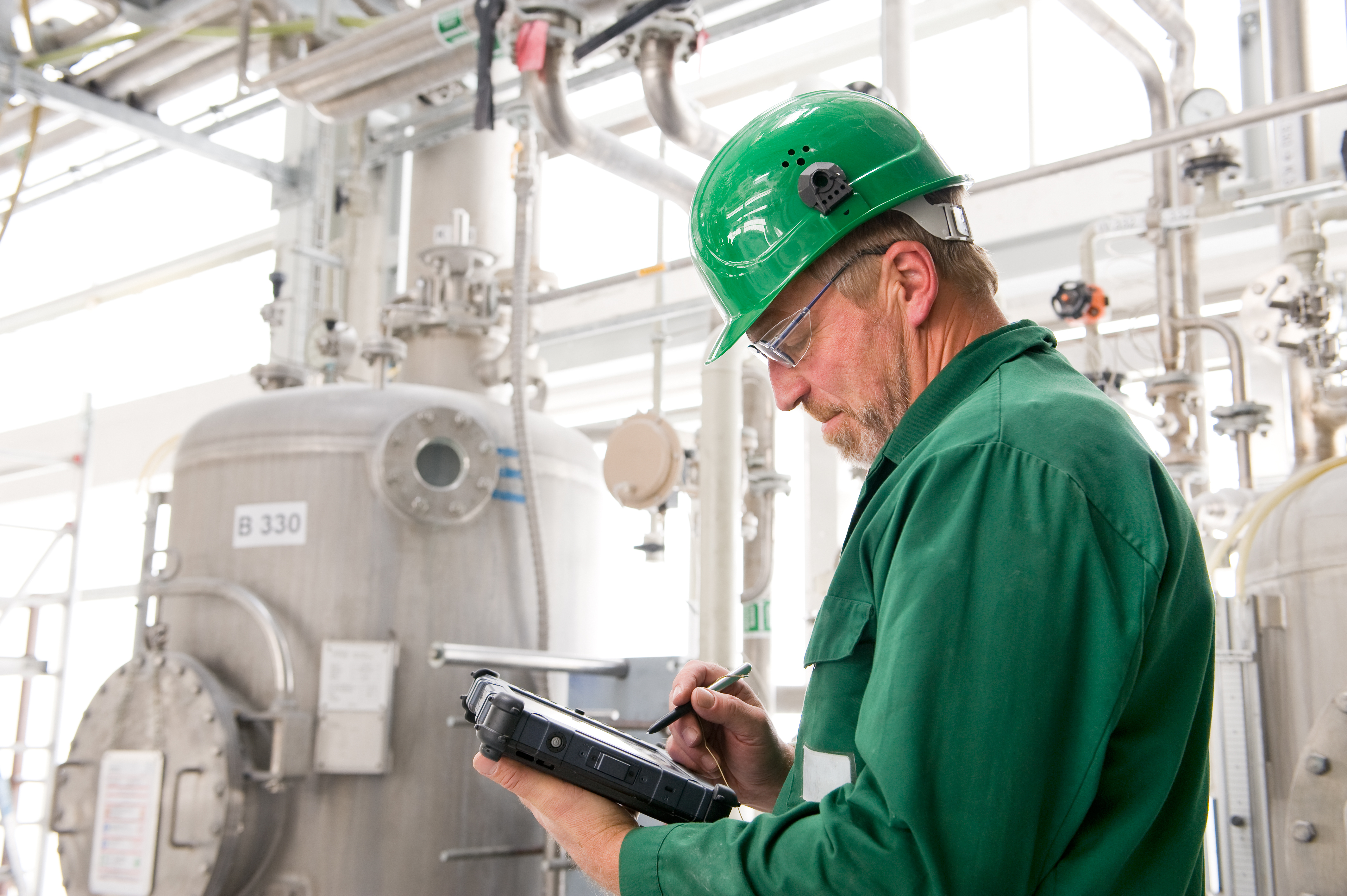Atechnical animation that visualizes the synchronization of three Triplex process diaphragm pumps in different operating states was one of the highlights at Lewa’s booth at the 2016 ACHEMA show. The objective of this kind of simulation is to reduce pressure-induced pulsation and to prevent formation of pipe vibrations that are harmful to the system. Having a detailed pulsation study is essential for optimizing a complex piping system. Lewa of southwestern Germany is the only pump manufacturer in the world to have an internally-developed software program for performing numeric simulations and examining API-674 criteria during the system dimensioning process. Lewa recently added a powerful one-dimensional model for Computational Fluid Dynamics (CFD) in order to obtain precise statements about dynamic processes or pressure amplitudes, such as when pumps are running in parallel.
Particularly with reciprocating positive-displacement pumps, interactions between connected pipelines and other parts of the system are an important factor. Especially when large pumps with high hydraulic output are used, the designer must be sure in advance that the entire structure of the system is properly balanced. By performing pulsation studies early in the planning phase, Lewa can ensure that the entire system will run reliably and more safely.
The studies incorporate not only the complexity of the system, but also the kinematics, the number of cylinders of the pump, and the stroke frequency range. The properties of the fluid, such as viscosity, compressibility, vapor pressure, and sound velocity also play important roles during dimensioning. During the planning phase, all analyses are performed in the form of computer simulations that run on Lewa’s own software, known as PumpDesign. During simulation, pressure pulsations and their frequency spectrum are examined in detail in order to uncover and avoid the potential for cavitation and overloads in advance.

Synchronization of several pumps is an effective way to reduce pressure pulsations and vibrations in the pipelines. Lewa has developed a powerful CFD software module for making accurate statements about dynamic processes or pressure amplitudes and properly dimensioning the entire system.
TESTING FRICTION MODELS
These calculations are used to optimize pulsation damping and piping dimensions in order to prevent the appearance of typical problems, such as fatigue damage on pipelines and other components. For these needs, one-dimensional CFD simulation is usually the best compromise between precision and calculation time. The Navier-Stokes equations, which fully describe fluid dynamics, require too much calculation time to be solved directly for large and complex systems. Therefore, a few assumptions and simplifications are needed in order to obtain equations that describe the physical processes in pump pipeline systems with a good degree of accuracy.
In addition, even very long and complex piping systems must be solved quickly with a computer. In this simplified process, information about internal friction in the fluid, which was originally contained in the complete physical equations, is lost and must be “artificially” added back in at the end. Several approaches to modeling are available for this purpose.
Recently Lewa has focused on researching, testing, and validating the various friction models so they can be used in their one-dimensional CFD software. Lewa engineers have designed and constructed a complex pulsation test center for use as a validation tool that lets them compare simulations and measurements in real time. This serves as a yardstick for assessing the accuracy of the numerical forecast of each approach to modeling.

Recently Lewa has intensely examined various friction models that are used in the one-dimensional CFD software. A sophisticated pulsation test center was installed in order to have a point of reference for how accurate each calculation model’s numerical forecast really is.
“We installed a Lewa LDC-M910S metering pump in a Triplex configuration in the test system. The stroke length can be varied within a range of 0 to 15 millimeters. The maximum stroke frequency of the pumps is 420 spm,” according to Marco Klinkigt, physicist at LEWA´s Technical Product Management department. Absolute discharge pressure can be adjusted within the range of 1 to 146 bar. The pressure/time curve can be measured at many different positions during operation. The length of the line between the pump and the vessel can be adjusted from 20 to 80 meters. The path of the piping can be modified by opening or closing valves; resonators and damping devices can also be installed in various locations.
A LOOK AHEAD
Lewa has developed a powerful CFD software module for making accurate statements about dynamic processes or pressure amplitudes and properly dimensioning the entire system. In next month’s conclusion, we will compare the simulation results with the measurement to seek a clearer understanding of the benefits available to pump users employing this precise tool. ◆
About the Author:
Stefan Glasmeyer is managing director of Lewa GmbH, the world’s leading manufacturer of metering pumps and process diaphragm pumps as well as complete metering packages for process engineering. Lewa develops technologies and provides solutions for the vast array of applications among its customers. The products see use primarily in the oil and gas industry in applications involving gas odorization, petrochemicals and in refineries as well as in the manufacturing of plastics, detergents and cleaning agents. Additional application areas include the chemical industry, cosmetics industry, pharmaceuticals and biotechnology, food and beverage industry, and power supply utilities. For more information, visit www.lewa-inc.com.
____________________________________________
MODERN PUMPING TODAY, January 2017
Did you enjoy this article?
Subscribe to the FREE Digital Edition of Modern Pumping Today Magazine!
![]()


